Leather
Trevor James reveals the important techniques and skills he uses that ensure James Saddles will last a lifetime if properly cared for.
The most important parts of the saddle are the leather and the saddle tree. Our leather is tanned in the USA by Wickett and Craig, using only US and Canadian Hides. Unfortunately, the huge influx of imported saddles being sold via the chain store type of outlet, which have surfaced in every town in Australia, has caused the shut down of most saddle makers in Australia. It has followed that the Australian Tanneries have been forced to close as the market for their saddle leather has dropped off.
James Saddlery used only Australian leather at one point, but then changed to New Zealand leather as the Tanneries closed. The New Zealand Tanneries also closed for the same reason, CHEAP IMPORTS. Most of these imports are made of sub standard Buffalo Hide.
In the saddles, Trevor and Daniel now use European cowhide in the saddles under $2000 and leather imported from the USA in saddles over $2000. We also have Herman Oak leather available, but this will make the saddle price more expensive.
When the hides are delivered, the grain side of the leather is inspected for surface flaws and the flesh side for cuts that may occur during removal of the hide, the leather is approved for use. The very strongest and best quality part of the side lies along the back bone and this is kept in mind when the saddles are cut out, eg the bottom of the flaps, which are the areas where the highest wear occurs, is always put nearest the backbone. Is it the same situation with any high wear areas such as fenders, saddle skirts etc. These are always cut as near as possible to the backbone. Girth straps and stirrup leathers are always out with the buckle up end toward the backbone to ensure long life and maximum strength over years of use.
The best way to check the quality of leather is to fold the leather back on itself. The grain should remain tight and cohesive. If it separates and wrinkling occurs the leather is poor quality. The leather should also readily absorb oils or leather conditioners essential for preserving and protecting it. If the oil does not penetrate but sits on the surface it is an indication that the leather has a cheap substandard spray on finish which may look okay to the untrained eye, but will wear off over time and easily crack. Most copies of genuine Australian made saddles are made of buffalo hide. This is generally very poor quality and even when cut from the good part of the hide it exhibits all of the faults listed above.
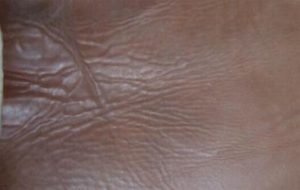
Above – Poor quality leather wrinkles when bent. 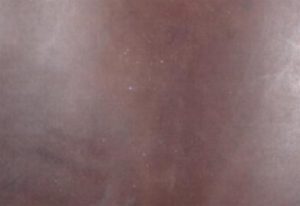 Above – This good quality leather when bent shows no wrinkling or separation at all.
Above – This good quality leather when bent shows no wrinkling or separation at all.
Saddle Trees
Wooden Trees
Australian saddle trees are entirely different to trees used in American style saddles. The traditional Australian tree for many years was made of wood and reinforced with a steel perimeter frame. The gullet steel was generally much thicker as that is where the most force is exerted. When the rider weight is on the stirrup leathers it is forcing the front forks of the saddle in a down direction. When the horse’s hooves hit the ground at the gallop the force travels back up through the horses shoulders. When these two opposing forces collide it has the effect of trying to split the saddle in two. The first signs of this are the tree spreading at the front and the saddle dropping on to the horse’s backbone. As the Australian style trees are only around ¾” thick at the front, the steel reinforcement must be extremely strong. In comparison, western trees with a horn and swell are several inches thick at the front and this gives them strength without much, if any steel reinforcement.
The wood and steel tree is still used by Trevor James because some customers want a saddle that is made true to the methods used in the originals or centuries ago. The originals were made using carved timber. The side rails, cantle and front forks were made of single pieces. These were joined together and the steel perimeter riveted in place. The inherent problems of these trees was that the side rails tended to crack along the grain when screwed or tacked. The steel gullets, though thick eventually cracked because of the never ending flexing of the front forks.
To maximise the strength of these trees Trevor James had the wooden sections of the trees made of laminated timber. This meant that each layer of timber is placed one on top of the other with the grain going length ways then cross ways. These layers are glued and pressed into their exact shape and when set are immensely strong in themselves because the laminated shapes once glued and set are bonded as one.
Trevor then discarded the usual 1″ steel perimeter and instead used a 1 1/2″ width to reinforce the side rails. The gullet though is the problem area where spreading and cracking occurs.
To eliminate cracking and eventual breakage, flex had to be eliminated. The steel gullet Trevor James uses is made of two separate layers of steel. These are heated and shaped. Placed one on top of the other they are stagger welded along the outer edge. Along the back edge of the now laminated steel gullet a shaped upright piece is welded. This has the effect of forming half of a tube. In order to distort or flex the welds would have to be broken.
Once the laminated pre formed gullet is made it is fitted to the underside of the tree. Another layer is placed on top of the timber and they are precision drilled and riveted through.
The wooden trees are web-strained. This is pretty much unique to Australian saddles. In the past jute webbing was used but was prone to decay and tacks used to hold it in place frequently cut through it.
Trevor James uses nylon webbing. This is extremely strong and wear resistant. In its protected environment of a saddles internal parts it will last the life of the saddle. The webbing, once strained down on the tree must remain at least a quarter of an inch above the side rails and be hard to the touch. You can see that the tree must be extremely strong. If it is weak enough to flex in its length as the web is pulled down into place the tree will start to pull one end towards the other allowing the web on to the side rails, thus defeating its purpose of suspending the rider above the tree. This collapsing of the web suspension system is aggravated by very little rider use if the tree is made of a weak material or not properly reinforced allowing excess flexing and distortion. Above – Timber tree has inch and a half steel side rails.
Above – Timber tree has inch and a half steel side rails.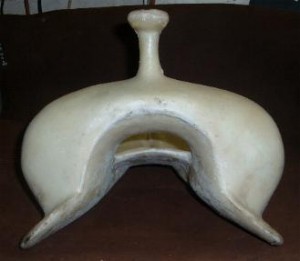 Above – American style trees are much thicker and do not need external steel reinforcement.
Above – American style trees are much thicker and do not need external steel reinforcement.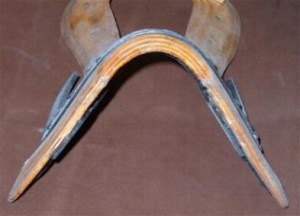 Above – The front forks of Australian style trees are around ¾” thick and must be steel reinforced. All of the wooden structure is formed in laminated sections.
Above – The front forks of Australian style trees are around ¾” thick and must be steel reinforced. All of the wooden structure is formed in laminated sections. Above – The gullet is reinforced with an inverted U shape piece of steel, which is welded top and bottom, thus making it into a tubular shape. A tube is extremely strong and this is designed to prevent flexing and the eventual breakage or spreading of the front forks. Any attempt to cold bend the tree will result in broken welds and will be done to the composite structure.
Above – The gullet is reinforced with an inverted U shape piece of steel, which is welded top and bottom, thus making it into a tubular shape. A tube is extremely strong and this is designed to prevent flexing and the eventual breakage or spreading of the front forks. Any attempt to cold bend the tree will result in broken welds and will be done to the composite structure.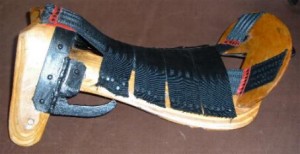 Above – The tree when web strained must have a nice side profile. The webbing should be a quarter of an inch above the side rails. The finished product must be hard to the touch. It must support the weight of a rider for the life of the saddle without coming down onto the side rails. If the tree can flex from end to end it will allow the webbing to collapse.
Above – The tree when web strained must have a nice side profile. The webbing should be a quarter of an inch above the side rails. The finished product must be hard to the touch. It must support the weight of a rider for the life of the saddle without coming down onto the side rails. If the tree can flex from end to end it will allow the webbing to collapse.
CARBON FIBRE TREES – Patent Number PQ4490
In a never ending quest to improve his saddles, Trevor James designed a tree incorporating wood and carbon fibre. This meant that the wooden frame work is entirely encased in carbon fibre. The wood being entirely in an airtight situation is fully protected and rot resistant. The carbon fibre wood composite was so strong that the steel reinforcement of the side rails was no longer needed, so weight was dramatically reduced. However, for maximum strength in the front forks the laminated solid steel gullet is still precision fitted. Aluminium is one of the weakest metals available but Trevor uses in conjunction with carbon fibre, but only at non critical points where screws need to grip such as support positions for saddle bag dees etc.
Any of the saddle trees outlined above can be custom made to suit particular horse shapes and in lengths to accommodate any rider. These saddle trees are precision made for maximum strength to ensure a life time of comfort for both horse and rider. As Trevor James has outlined, these trees are painstakingly designed to eliminate flexing in the gullet area which leads to spreading and eventual breakage.
It has come to the attention of Trevor James that some organisations particularly in the US are widening or narrowing saddle trees after the saddle has been made in order to fit particular horses. Please note that James Saddlery does not endorse or condone this practice of using massive force to cold bend metal gullets. This causes damage to metal which in some cases can only detected by x-ray. The damage to precision fitted laminated steel gullets and riveting systems is irreversible. Warranty to any James saddle is null and void if the tree has been subjected to cold bending by massive force. The structural integrity of the tree as a composite has in the case of cold bending been completely destroyed.
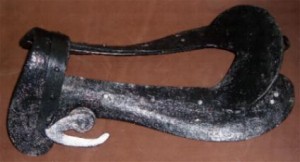
Above – The wooden structure of the tree is completely encased in carbon fibre and reinforced with aluminium at the pick up point for screws. The tree pictured is fitted with a rotating stirrup bar
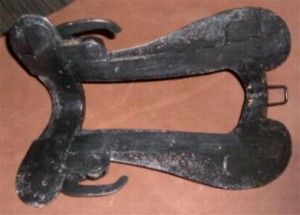
Above – when the tree has a rotating stirrup bar, it still has a full steel perimeter to ensure maximum strength for the rotating stirrup bar.
Tooling
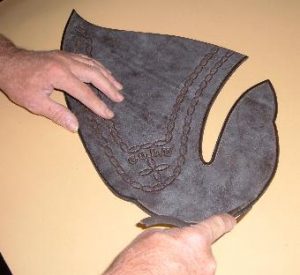
Above and below- The stitch lines are especially grooved out so the stitching is recessed. This prevents the stitching from being worn out by the riders leg movement.

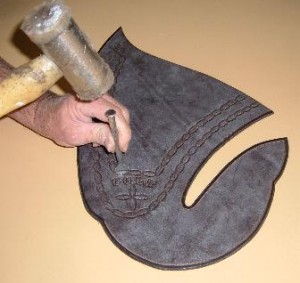
Above – Hours of work go into the intricate designs. Each and every part of the tooling is painstakingly stamped into the leather using small tools like this.
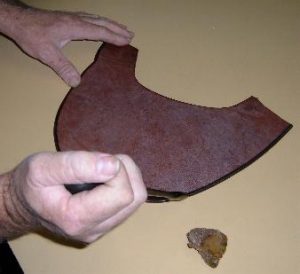
Above – The edges are done with a special tool that melts hot wax into the leather. This leaves a nice decorative edge, but the main reason is to prevent water penetration.
ATTENTION TO SMALL DETAILS LIKE THESE MEAN THAT YOU GET EXTRA YEARS OF LIFE OUT OF YOUR SADDLE.
YOU JUST DONT GET THESE REFINEMENTS IN THOSE CHEAP COPIES YOU SEE ADVERTISED FOR A COUPLE OF HUNDRED DOLLARS.

